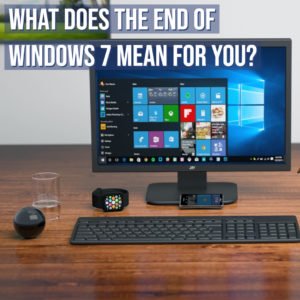What Windows 7 End of Support means for businesses

No one likes forced technology changes, whether your laptop dies or your operating system is upgraded. You’re used to what you have, and updates can be costly, confusing and cause downtime. As technology continues to advance, however, change is inevitable.
You might have heard recently that Microsoft is ending support for Windows 7. Those who haven’t heard likely will soon receive increasing notifications as the End of Support (EOS) or “end of life” for Windows 7 nears.
If your organization relies on Windows 7, this can be alarming news. Here’s what you need to know to prepare for Windows 7 end of support.
What happens when Windows 7 support ends?
Microsoft has announced that support for Windows 7 will end January 14, 2020. This means that after this date, Microsoft will no longer provide support for technical issues, software updates or security updates.

You can still use Windows 7 after this date, but you will be exposing yourself and your organization to increased risk. While any internal antivirus tools or security software you use can certainly help, there are still vulnerabilities.
The lack of support can also cause other issues. Hardware and software manufacturers, for instance, have likely already moved away from Windows 7 as they naturally build toward the newest operating systems. While it might take several years, organizations that continue to use Windows 7 will eventually run into compatibility issues with hardware and software.
What you can do
Microsoft recommends moving to a new PC with Windows 10. For large organizations with many computers using the operating system, this is a huge ask.
Microsoft also provides options to upgrade compatible PCs to Windows 10. But as even this might be a big task for large companies, Microsoft is allowing some users to purchase Extended Security Updates through January 2023. Extended Security Updates mean support engineers will open support tickets and work to solve issues, but they won’t dig down to the root issue or work on a global fix for the problem.
It’s clear that sticking with the soon-to-be obsolete operating system only delays the inevitable.
Many companies have turned to Windows 7 because it was tried and true for years, so upgrading company-wide is a huge undertaking. This requires advanced planning, especially if this is a national rollout.
Because of this, even with the Extended Security Updates options, it’s important that companies start making the move from Windows 7 sooner rather than later.
How CPT can help
Changes in technology can come with complications. If upgrades do not go as planned, you and your organization can lose precious work time dealing with loss of service. If you aren’t familiar with all aspects of your system, you might also run into unexpected issues, like hardware or software that is not compatible with your new operating system or that needs to be reconfigured to work correctly.
For companies that need extensive upgrades, staff might be required to spend additional time planning and managing the rollout so it is done in a limited time frame.
CPT can help alleviate these issues and take the Windows 7 upgrade off your plate completely so your staff can focus on your customers, not IT. We are a national technical project management company—and this is exactly what we do.
Our technical prowess means we can plan the rollout precisely so your locations receive updates within your timeline and without disruption. We can also provide onsite techs who can troubleshoot any unexpected issues immediately.
Finally, we have a national reach, so you know that wherever your technology is, it will be upgraded consistently, quickly and with the support you need.
If you have any further questions about what Windows 7 End of Support means for your company or how CPT can help, please don’t hesitate to reach out. Give us a call at 630-735-7000 or email us at sales@cptnetworks.com.